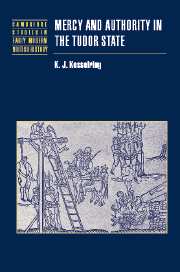Book contents
- Frontmatter
- Contents
- Acknowledgments
- Abbreviations and conventions
- 1 Introduction: mercy and the state
- 2 Changing approaches to punishment and mitigation
- 3 Changing approaches to the pardon
- 4 Patronage, petitions, and the motives for mercy
- 5 Public performances of pardon
- 6 Protest and pardons
- 7 Conclusion
- Appendix I Sources
- Appendix II Benefit of the belly
- Bibliography
- Index
- Titles in the series
3 - Changing approaches to the pardon
Published online by Cambridge University Press: 05 July 2009
- Frontmatter
- Contents
- Acknowledgments
- Abbreviations and conventions
- 1 Introduction: mercy and the state
- 2 Changing approaches to punishment and mitigation
- 3 Changing approaches to the pardon
- 4 Patronage, petitions, and the motives for mercy
- 5 Public performances of pardon
- 6 Protest and pardons
- 7 Conclusion
- Appendix I Sources
- Appendix II Benefit of the belly
- Bibliography
- Index
- Titles in the series
Summary
In July of 1582, Agnes Waters and four other women of the town of Godalming faced the fearsome spectacle of the queen's justices at the Kingston assizes. The women found themselves caught in the ever-widening gaze of the state, standing trial for a crime only recently defined at law: witchcraft. A jury acquitted the other women, but Waters admitted that she had in fact bewitched ten bullocks and a cow to their deaths. While Waters had the misfortune of being charged under one of the many new statutes, she was saved from punishment by something else that became more readily available in these years: a royal pardon.
Punishment and mercy coexisted as strategies of power in the increasingly centralized, increasingly intrusive Tudor state. Both shaped the exercise and experience of authority. In conjunction with the growth in the scope and severity of the law emerged a set of changes that demonstrated the increasing importance of mercy and ensured that people might more easily avail themselves of its benefits. Pardons became more frequent as the years passed, an increase helped in part by changes to the methods with which the Tudors distributed and displayed their clemency.
Although late medieval kings had sporadically issued proclamations or statutes of general pardon that offered forgiveness for a host of offenses, these devices appeared with much greater frequency in the sixteenth century and became a standard part of parliamentary business.
- Type
- Chapter
- Information
- Mercy and Authority in the Tudor State , pp. 56 - 90Publisher: Cambridge University PressPrint publication year: 2003



